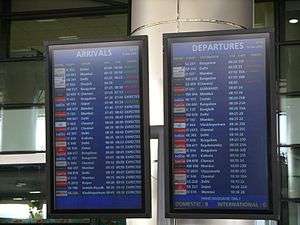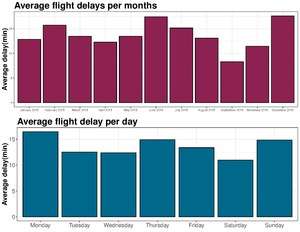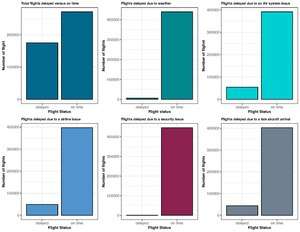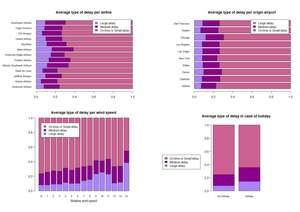Flight cancellation and delay
A flight delay is when an airline flight takes off and/or lands later than its scheduled time. The Federal Aviation Administration (FAA) considers a flight to be delayed when it is 15 minutes later than its scheduled time. A cancellation occurs when the airline does not operate the flight at all for a certain reason.

In the European Union, Flight Compensation Regulation 261/2004 states that flight delays for over three hours, cancellations and denied boarding entitles passengers to a compensation from €250 up to €600 per passenger from the airline.[1]
In the United States, when flights are canceled or delayed, passengers may be entitled to compensation due to rules obeyed by every flight company, usually Rule 240, or Rule 218 in certain locations. This rule usually specifies that passengers may be entitled to certain reimbursements, including a free room if the next flight is the day after the canceled one, a choice of reimbursement, rerouting, phone calls, and refreshments. When a flight is delayed, the FAA allocates slots for takeoffs and landings based on which flight is scheduled first.[2] The Transportation Department imposes a fine of up to $27,500 per passenger for planes left on the tarmac for more than three hours without taking off (four hours for international flights).[3] In the United States, passengers are not entitled to compensation when a delay occurs, not even a cut of fees airlines must pay federal authorities for long delays. Airlines are required to pay for lodging costs of passengers if the delay or a cancellation is through their own fault, but not if the cause is beyond their control, such as weather.[4]
Causes
Since 2003, the United States Bureau of Transportation Statistics has been keeping track of the causes of flight delays.[5] The number of flight delays has increased as staff has been cut back as a result of the financial woes following the September 11 attacks.[6]
Some of the causes of flight delays or cancellation include:
- Airline glitches. The top cause of flight delays, according to a USA TODAY analysis.[6]
- Congestion in air traffic[6]
- Earthquakes and tsunamis (e.g., in the event of 2004 Indian Ocean earthquake and tsunami, 2010 Chile earthquake, and the 2011 Tōhoku earthquake and tsunami)
- Fueling[7]
- Inclement weather, such as thunderstorm, hurricane, or blizzard[7]
- Late arrival of the aircraft to be used for the flight from a previous flight[7]
- Maintenance problems with the aircraft[7]
- Security issues[7]
- Terrorist attacks (e.g., suicide bombing in the event of Domodedovo International Airport bombing, the 2016 Brussels bombings, and the 2016 Atatürk Airport attack)
Effects
Cost to airlines
In the United States, the Federal Aviation Administration estimates that flight delays cost airlines $22 billion yearly.[8] Airlines are forced to pay federal authorities when they hold planes on the tarmac for more than three hours for domestic flights or more than four hours for international flights.[4]
Cost to passengers
Flight delays are an inconvenience to passengers. A delayed flight can be costly to passengers by making them late to their personal scheduled events and commitments. A passenger who is delayed on a multi-plane trip could miss a connecting flight. Anger, frustration and even Air rage can occur in delayed passengers.[2]
Compensation
Flights from the US to the EU on EU airlines are covered by Regulation 261/2004. This requires airlines to pay compensation of up to €600 if the flight is delayed more than three hours on arrival (four hours for long-haul flights).
Flights to the US from the EU are covered by the regulation regardless of the airline. This means a US airline can still be required to pay passengers compensation under Regulation 261/2004.
For example, a flight departing London to New York on American Airlines would be covered by the regulation, but the return journey on the same airline would not. The New York to London flight on an EU carrier, such as British Airways or Virgin, would be covered.
Flight delay data in the USA

Yearly data analysis
Based on flight delay data from 2015 some correlations can be shown.[9] The analysis focuses on America's ten biggest airports, those are; Atlanta, Chicago, Dallas, Denver, New York (JFK), Los Angeles, San Francisco, Las Vegas, Seattle and Charlotte. Data analysis confirms that the distribution of delays at departure is very similar to that at arrival and there is a strong correlation between the two data. Observed is namely the average time of delay per month and the tendency of delays depending on the days of the week. It is clearly noticed that the average delay of a flight was larger in February, June, July and December. This seems to be strongly correlated with holiday periods. As can be expected September has a rather low average delay. One can derive that the probability of encountering a flight delay is larger in the above-mentioned months. Also, the busiest days to be flying are mainly Mondays, Sundays and Thursdays. Fridays are also a popular day to be flying.
Causes of delay

There are several causes for a flight to be delayed. It is interesting to look at the proportions or chances of encountering certain delay type. More than half of the fights tend to be late (this taking account minor delays such as 5 or 10 min delays). Most planes are late due to air system issues or airline delays. This is interesting because it means that it is an area of the airline industry that could be optimized. Supporting our argument, one notices that the lower amount of delays are caused due to weather and security issues. Showing us that security for example is optimized to a very large level and other types of delays could eventually be avoided by optimizing organization in airports or establishing a delay prevention schedule. Weather delays are rather rare and are not primary reasons for flights to be delayed.
Performances

This section illustrates performances of Airlines and Airports in being on time in 2015, the focus is on the USA's ten biggest airports, namely; Atlanta, Chicago, Dallas, Denver, New York (JFK), Los Angeles, San Francisco, Las Vegas, Seattle and Charlotte. Delays are divided into three categories, namely "on time or small delay" (up to 15 minutes delay), "Medium delay" (15 – 45 minutes delay) and "Large delay" ( 45 minutes delay). In this way the graphic representation is more understandable as well as the possibility of directly comparing the variables related with delays. As represented one can observe that Airlines that were particularly good at being on time compared to other airlines were Delta Air Lines, American Airlines and Alaska Airlines. Those that tend to have a larger delay are Spirit Airlines, American Southeast Airlines and Frontier Airlines. Even if some observations can be made one cannot say that one airline is better than another. The same type of analysis can be one for different airports. In this case one can observe that airports such as New York and Atlanta stand out positively, while the one with the worst frequency of delays is Chicago. However, the differences are less obvious and, generally speaking, one can conclude that airlines play a more significant role than the airports of departure. Finally, the weather variables (humidity, wind speed) and holidays are analysed. After observing that the correlation between humidity and delays is almost zero, one could notice that both the wind speed and the holidays instead have a certain impact on flight delays.
See also
References
- EC Regulation 261/2004
- Hanna, Julia (August 31, 2011). "Improving Fairness in Flight Delays". HBS Working Knowledge.
- Yu, Roger (August 21, 2011). "New rules for airlines kick in this week to protect fliers". USA Today. Retrieved 15 September 2011.
- Choi, Candice (August 31, 2011). "When it comes to weather-related flight cancellations, airlines are off the hook". Boston.com. AP. Archived from the original on 16 May 2012. Retrieved 15 September 2011.
- "Airline On-Time Statistics and Delay Causes". Bureau of Transportation Statistics. Retrieved 15 September 2011.
- Levin, Alan (December 22, 2007). "Airline glitches top cause of delays". USA Today. Retrieved 14 September 2011.
- "Understanding the Reporting of Causes of Flight Delays and Cancellations". Bureau of Transportation.
- Rapajic, Jasenka. Beyond airline disruptions. p. 16.
- "2015 Flight Delays and Cancellations". www.kaggle.com. Retrieved 2018-12-02.